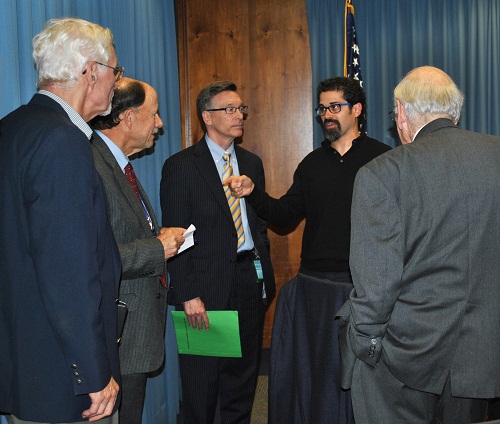Steve Winkelman on Transportation System Resilience: “Can We Get There from Here?”
With extreme weather on the rise, the United States is experiencing, with increasing frequency, disruptions to the nation’s transportation systems. Volpe’s new speaker series, Transportation System Resilience, Extreme Weather, and Climate Change, features thought leaders engaging in dialogues on this emerging topic. The Volpe series, which will continue into the spring, addresses the multimodal and multi-sector issues of transportation system resilience. Extreme weather has impacts on the transportation system ranging from runways softening to rail tracks buckling.
 Steve Winkelman, director of Transportation and Adaptation Programs at the Center for Clean Air Policy, was the series’ first speaker. Greg Winfree, Administrator of the Research and Innovative Technology Administration of the U.S. Department of Transportation, kicked off the series.
Steve Winkelman, director of Transportation and Adaptation Programs at the Center for Clean Air Policy, was the series’ first speaker. Greg Winfree, Administrator of the Research and Innovative Technology Administration of the U.S. Department of Transportation, kicked off the series.
Winfree discussed President Obama’s Climate Change Action Plan that was rolled out in June. The plan addresses the steps that must be taken to cut carbon pollution and prepare for the impacts of changing climate. Winfree noted that climate and weather disasters cost the U.S. economy more than $100 billion in 2012.
Speaking on transportation and climate adaptation, Winkelman posed the question, “Can we get there from here?” He noted, “We have a lot of challenges. We have a lot to learn on transportation and climate adaptation,” and offered that his talk would “help frame what kind of problems we’re facing, what solutions we know about, and some of our needs going forward.”
Winkelman argued that as a nation, we need to invest in ways to reduce greenhouse gas emissions and also invest in ways to help our systems adapt to climate change. “It used to be that working on adaptation was giving up,” he said, but “it is clear that there is enough warming built into the system that we are going to need to do both. “
He encouraged those involved in land use and infrastructure decisions to always “ask the climate question” to be clear how those decisions impact greenhouse gas emissions and resilience to climate change impacts.
Hard work and better coordination needs to occur to have a more resilient infrastructure, according to Winkelman. He gave several examples of how governments and metropolitan planning organizations are taking steps to cope with severe weather events.
The long-term solution to transportation system resiliency is not just about cleaning up after events and repairing the infrastructure, but planning for and designing infrastructure with the current and future climate in mind. This will ensure that the nation’s transportation infrastructure can withstand more severe weather events. Winkelman provided some examples:
- Collecting information on local, non-climate factors like infrastructure state of repair is a proactive measure that can be part of the solution.
- Updating flood maps to include climate scenarios can better prepare local, state, and federal agencies to deal with extreme weather.
- Educating stakeholders and decision makers from a central location eases communication and allows for everyone to be on the same page.
The skills to deal with extreme weather events and to build a secure infrastructure already exist; floods, fires, and storms are not new events. Our goal must be to plan ahead, pool public and private sector resources, and invest in a more resilient infrastructure. Winkelman observed that we must seize every opportunity at the state, MPO, and local level to improve infrastructure resilience.
The schedule and speaker bios for Volpe’s Transportation System Resilience, Extreme Weather, and Climate Change speaker series can be viewed on our website.
Full Video from the Event
| Greg Winfree, RITA's Administrator, introduces Volpe's new climate change speaker series. | |
|
Part 1/4 of Steve Winkelman's talk on transportation system resilience. Winkelman introduces his current work, publications, and goals of the Center for Clean Air Policy. |
|
|
Part 2/4 of Steve Winkelman's talk on transportation system resilience. Winkelman on defining the "problem" and the "solutions." |
|
|
Part 3/4 of Steve Winkelman's talk on transportation system resilience. Winkelman speaks about what's needed for implementation of more resilient transportation systems in the face of climate change and extreme weather. |
|
|
Part 4/4 of Steve Winkelman's talk on transportation system resilience. Winkelman speaks about what's needed to continue to make progress in the movement to make our transportation systems more resilient in the face of climate change and extreme weather. |

